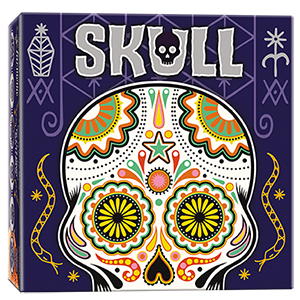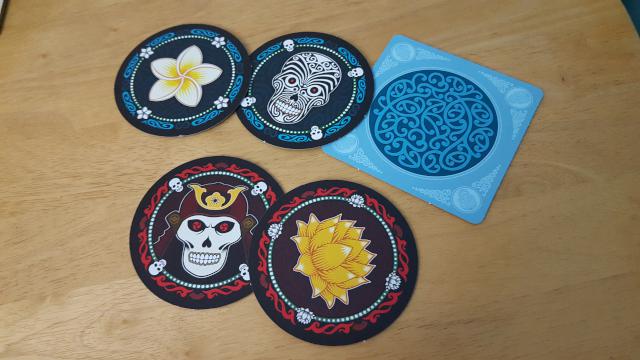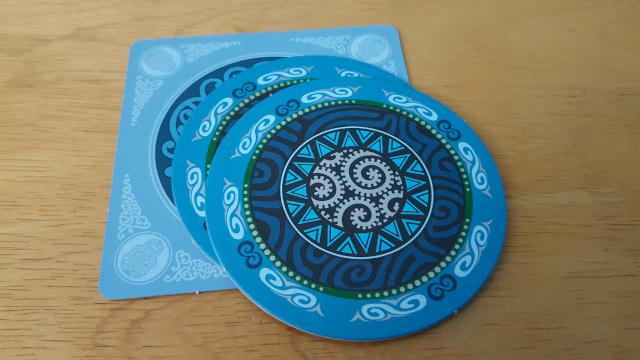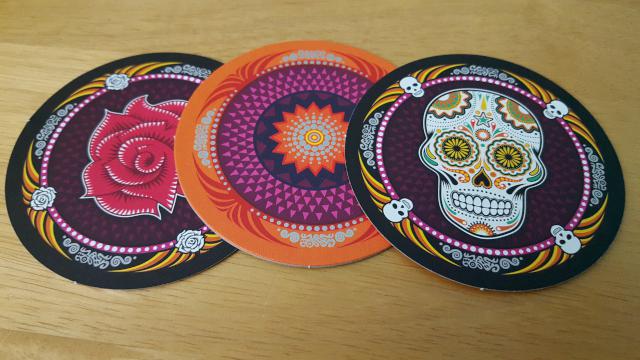
Since we started covering tabletop games a few months ago we’ve reviewed some excellent, but mind-blowingly complex games. Some take hours to complete a single game, others take so long that their boxes are even designed to “save” your progress part-way through. But Skull heads in an entirely different direction, giving you just a pile of beautifully designed coasters in the box and some incredibly easy to follow rules which you’ll learn in minutes. The result? A hugely enjoyable game which will have you swearing at your in-laws without a second thought. Who can turn down that opportunity?
The idea of Skull is to bluff your way to victory while also relying on a small amount of luck in the process. Each player starts their game with a set of four coasters; three contain a picture of a flower, while the other has a skull. The route to victory is a simple one in principle: you just need to win two rounds. In practice though this proves to be a much greater challenge thanks to the determination from every other play to trick you into losing your coasters one by one. Each round starts with every player placing one of their coasters face down on top of their team mat, without other players seeing what they’ve placed down. That’s not to stop them from telling everyone which coaster they’ve apparently used though, for reasons which will become clear later on. Once every player has placed a coaster, play passes to the first player again. This is where things start getting interesting.

The first player can decide whether to play another coaster on top of the one already played, or make a bid of how many coasters they think they can turn over without revealing a skull. If they play another coaster, play passes to the next player who can make the same decision and so on round the table. As soon as someone makes a bid, however, nobody can put anything more onto their pile. From this point on each player can decide to raise the bid to turn more coasters or pass their turn, the latter of which drops them out of the bidding process. As soon as there’s only one bid left and all other players have passed the player remaining becomes the challenger, and by far the most enjoyable part of the game kicks off: the reveal.
The basic idea of this final stage is the challenger needs to turn over as many coasters as their bid promised without revealing a skull. The twist here is that they need to turn all of their placed coasters over first, so if the challenger themselves played a skull then there’s every chance they’re already stuffed – it happens a lot, usually as part of a bungled attempt to trick people into bidding a higher number. Seeing people’s faces when they realise they’ve just screwed themselves is a brilliant moment which never gets boring, especially if they’ve already tricked you once or twice in the game. If a player flips their own skull they can choose a coaster from their set to discard from the game; nobody else will know whether a skull or flower has been discarded.

Assuming though that said player flips their own coasters without any drama they can pick and choose which discs to turn over next, just as long as they’re turning the top card on any remaining pile. This is the precise moment that people start to get a bit cross with each other… players start to plant seeds of doubt in the challenger’s mind, pointing out that another player has already lied through their teeth on several occasions, all the time doing your own job of conning the challenger into believing your own coasters are all flowers when your skull is sat on top (or, indeed, vice versa). When we played it, phrases which came out quite regularly included “you can’t be lying again…”, “that’s a skull isn’t it… is it? Why won’t you tell me…” and my favourite one of all: “you’re sleeping on the sofa tonight”. I’ve cleaned them up a bit too, as you can probably imagine.
If the player does indeed manage to turn enough coasters and avoids the skulls then they win the round, and flip their team mat over to show they’ve won a round. If, on the other hand, they reveal a skull from another player’s pile that player can choose a random unseen card from the challenger’s set, again discarding it from the game completely. As the game moves on and players start to lose more cards their game gets even tougher – if you don’t have any more cards to place on your turn then you’ve got no option but to challenge and make a bid, something other players can make the most of if they know it’s about to happen.

The art work is fantastic, it’s very clearly using a theme of tattoo art but even if that’s not your thing it shouldn’t let it put you off, it’s a very attractive set of components. Each set of team coasters has its own unique design and style, and trying out the various designs can make a nice change to the action. It’s a nice compact box too, so will fit nicely on the shelf between two of your other huge games. There’s very little to complain about, although the surface of one of my cards did tear slightly when I popped it out of the cardboard mount. That could well have been my clumsy fingers though as it only happened the once out of a couple of dozen coasters.
So in a market of tricky to learn and slow to play board games, Skull stands out as a quickly paced and extremely easy to play game which can be played with pretty much anyone with anything near a basic comprehension of how bluffing is meant to work. That means you can play with your teenage kids, pension-age parents or anyone else in between and still manage to have a great time in the process. Trying to psych out other players is great, and the breath-holding moments of trying to flip the final coaster in your bidding attempt only to find some git has put their skull down is brilliant, even if your’e on the receiving end.
If you’re after a modern, enjoyable family game which will keep you occupied for a couple of hours at a time then give this serious consideration, it’s really rather good.
Skull
Available Now, RRP £14.99
Find your local stockist here

Leave a Reply